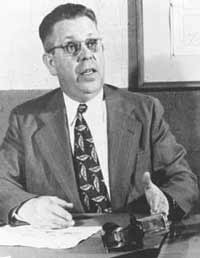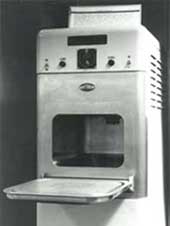Microwave Ovens
Microwave Ovens
A microwave oven uses radio energy to produce heat in substances such as food. Today’s household microwave ovens consist of an electronic device called a cavity magnetron which produces microwave energy, a waveguide that guides the energy in the right direction, and a metal enclosure, which traps that energy until absorbed by food or another material.
The first microwave ovens were developed around 1946, when in a bit of serendipity, engineer Percy LeBaron Spencer noticed that microwave communication equipment could be used to heat foods. Spencer had a chocolate bar in his pocket and noticed (no doubt messily) that the candy melted when he was near some microwave equipment. Quickly coming to the conclusion that other types of food could be heated that way, the Raytheon Company, Spencer’s employer, filed the first patents for a microwave oven later that year.
Early microwave ovens were much larger than those we have today—about the size of a refrigerator. These were sold in limited numbers to restaurants. It was not until after about 1965, after Raytheon acquired Amana Refrigeration, Inc., that they became smaller and less expensive. By the mid-1970s they were selling in the millions.
Microwave ovens use a modern version of the cavity magnetron, which has been used since the 1940s in radar sets. In fact, the first microwave ovens carried the brand name Radarange. All microwave ovens used for heating food operate at 2450 MHz—this is the frequency at which radio waves interact strongly with water molecules in the food, while passing through other things (like plastic and dishes) without heating them. There is enough water in most foods to allow the microwave to do its work. Even popcorn seeds contain just enough moisture so that absorption of the microwave energy causes the water inside the seed to turn into steam, increasing the internal pressure until it bursts. Many metals will reflect microwaves; and utensils, aluminum foil, or other metal objects placed in a microwave oven may disrupt the microwave, causing electrical arcing between the metal and the oven walls. This can catch food on fire or damage the oven. Nevertheless, metal can also actually help microwaves cook and heat food. Carefully designed metal foils called “susceptors,” which absorb microwaves and become hot, can be placed in contact with foods so that when the foil heats up it helps cook the food more effectively. You have probably seen these in a bag of microwave popcorn.
Since its widespread adoption, the microwave has had a great impact on the way foods are prepared, and what kinds of foods are eaten, although they are now more commonly used for reheating food rather than cooking it. The use of the microwave oven has virtually eliminated demand for prepared meals (or “TV dinners”) in aluminum trays, which were widely used in the 1950s and 1960s. Many foods that took a long time to cook or heat in a conventional (electric or gas) oven, such as whole potatoes, are today prepared in minutes. However, the microwave oven has well known limitations. It can’t produce a crispy brown crust on foods like a conventional oven can, for example. Also, because they can heat things so quickly, food sometimes becomes overheated, and some items like potatoes can even explode, creating a mess. The same things are possible in ordinary ovens, but it is easier to make a mistake with a microwave oven because it happens so quickly.

